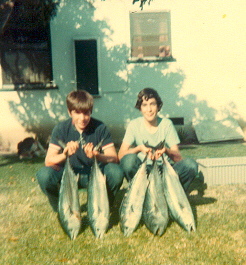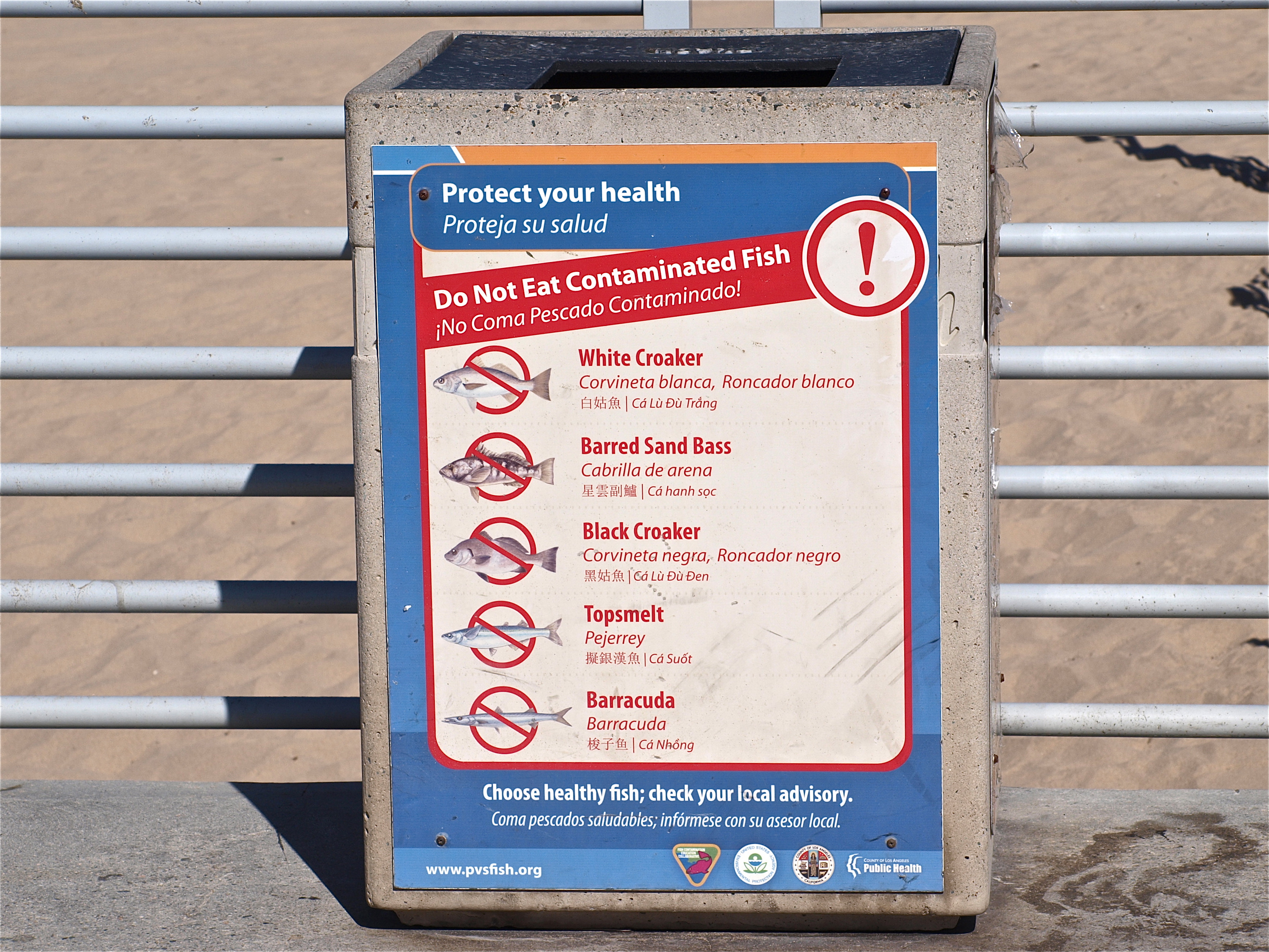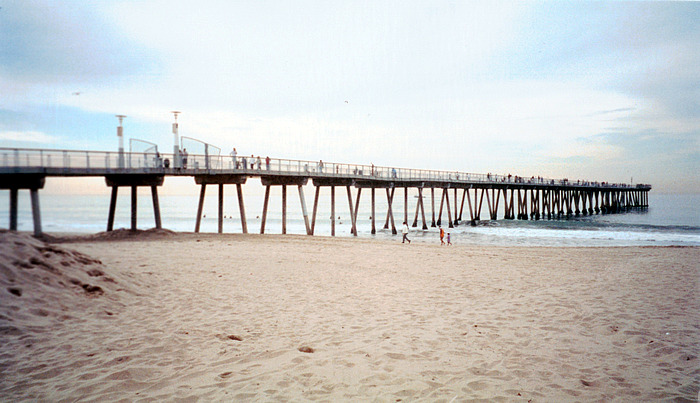Posted by mola joe — Bonito weren’t always pint size
Here’s an old shot of me (skinny one on right) and my buddy Jon from 1972. These bonito were caught right at the mouth of Redondo Harbor, but we hooked many big ones on Hermosa Pier that year also. Small fish in the picture went 9 pounds, and the biggest just over 15. Bonita this size fight harder than albacore or bluefin of equal size. Guys were getting dusted from the rocks at Redondo when these big bones would go through. It was the only year, if I remember right, that I caught bonito over 10 pounds from Hermosa Pier. We would throw Christy 2 blue and white jigs on 20 pound jig sticks and get blown away by these big fish. Really hard to keep them out of the pilings when you hook them off the pier. I remember blowing up a Squidder Jr with a plastic spool after setting the hook into a big bonehead. Maybe someday they will return in this size and the numbers we used to see. Watching a school of 10 pounders chase down a splasher and feather rig while watching it all from the height of a pier is nothing short of heart attack time!!!

Date: July 30, 2004; To: PFIC Message Board; From: Mola Joe; Subject: Fishing a pier the boater’s way.
I don’t get a chance to drop in as much as I used to, but I still see the pier-boat report issue still going on, oh well. Anyway, pier fisherman can really take some tips from the boater crowd to push the odds in their favor. I see so many people set up shop in one spot on a pier and stick it out without ever moving, even though they haven’t been bit the whole day. I know weekends can be rough on some piers as far as spots go, but it does pay to move throughout the day (if possible) if you’re not getting fish. Can’t count the number of times I’ve caught legal flatties on the first cast in a new spot after going fishless elsewhere. When it comes to halibut, boaters have it all over pier fisherman because of the amount of water they can cover on a drift. Tilt the odds in your favor by covering water on a pier the same way. One of the best pier halibut fisherman I knew covered water by casting and slowly dragging live baits all day from Hermosa Pier. During the week when crowds were off, he would cast out and walk 50 yards down the side of the pier with his reel in free spool, then slowly work his live bait back to him, just as a slow drift would be on a boat. He covered a lot of water all day and had halibut in the freezer all season. Yes, it’s more work than just casting and hanging the rod in the holder, but if you seen the amount of legals he caught, you wouldn’t mind. He would even nose hook frozen anchovies and drag them early in the season before live bait showed up and catch quality fish.
Chumming is another method that boaters do that seldom gets used on a pier. Chumming an area with crushed fresh mussel is a great way to get the perch to come to you when you’re fishing a pier. For mackerel, you’ll out fish everyone by throwing a small handful of cubed mackerel in the water and following it up by flylining a small mackerel strip right on top of it. Let your bait slowly sink with the chum and you’re going to catch fish.
The last tip pertains to all kinds of fishing, from albacore to crappie, but isn’t followed by enough people. It separates the rookies with empty sacks from the guys who catch fish more times than not. If you’ve ever fished a party boat for tuna, yellowtail, calicos, etc, there always seems to be a few guys catching way more than everyone else. This happens on piers and lakes as well, but shows more easily on sportboats that fish live or fresh cut bait. The reason these guys are catching more fish is kind of a catch 22 sort of speak. By catching more fish, they change bait more. By changing bait more often, they catch more fish. When I was a kid and first started fishing the sport boats, my dad had to tell me over and over to keep a fresh bait on. Not bit in 5 minutes, get a fresh bait. Of coarse you can’t change bait every 5 minutes on a pier (not unless you have an endless supply) but no question you’ll catch more fish with a fresh hot live anchovy, fresh piece of mussel, squid, etc. DO NOT bring in a chunk of mackerel that’s been soaking all morning and throw it back out to sit for another hour just because it looks pretty good. Some old time halibut fisherman swear big halibut will not hit a live bait that has teeth marks in it from another fish. Not sure if it’s true, but I change baits if it’s been raked even though it’s still alive. If you’re going to invest the time and money to get to the pier and fish for the day, invest a few dollars more and buy another pack of bait so you can keep things fresh on the end of your line. Live bait can be hard to catch at times, but well worth the effort to keep hot lively baits rotating on your rods. Back when big bonito were common on local piers, the rods with fresh lively baits out got bit 10 to 1 over baits barely swimming. Which brings us back to the guy catching all the fish is changing bait twice as much as everyone else because he catching twice the amount of fish. Fresh bait = more fish = more fresh bait = more fish, and so on. Even sharks and rays prefer fresh over old. Keeping fresh baits on doesn’t guarantee success, but over time will get you closer to that 10% of fisherman that catch 90% of the fish, whether you’re on a boat, pier, or shore. Take care everyone.

<*}}}}}}}}}>< —In 2003 Pier Fishing In California ran a writing contest with entries for fiction and non-fiction. Mola’s Joe’s non-fiction account was near the top.
Mola Joe — Hermosa Pier 1974 — This may sound like fiction to most, but this is the story the way it happened one summer day on Hermosa Pier. The year is 1974, and like most summer mornings of my youth, my mom drops my brother and I off at the foot of the pier an hour before daybreak. We rush to the end corner to set up the rod holders and rig the rods. The pier is already filling fast. Most have already cast their sinkers out and snapped the swivels and leaders on their line, to slide down a fat anchovy as soon as Frank, the owner of the bait shop, opens and starts to sell live bait. The bait line is already forming. It’s funny to see everyone with their live bait tickets in hand, waiting as they would at an amusement park, in anticipation of a heart-pounding ride. Some will get the ride of their lives today, most, myself included, will be heartbroken.
It’s daybreak and the big bonito are already starting to chase the larger-than-normal schools of anchovies that are balling up around the pier. Nothing more exciting than watching your slider with a big lively anchovy hit the water and a school of 6-pound bonito come up to welcome it to breakfast. Rods are bent up and down the pier, and drags are smoking. What a sight! The sounds of battle filled the morning. What sound like gunshots, are in reality a wake-up call to those that have their drags too tight when the speeding rockets hit their lines. The unmistakable sound of tails thumping the deck of the pier can be heard from all corners as more and more come over the rail. Another great day on the pier is about to get a lot better!
A rod bends as a fisherman hooks up, but this time the reel spool doesn’t stop spinning. The big coffee-grinder spinning reel sounds as if it’s going to blow apart as the fish picks up speed and the bottom of the spool comes quick. First one, then another, then another. Giant bonito? We’ve caught bonito over 10 pounds on the pier before, and we’ve never seen them do this to tackle. Most are being hooked halfway down the pier, so my brother and I move to a new spot, right next to a pier icon, Bonito Joe, and his wife Marge. As I understand it, Bonito Joe was in his early ’80s and had been around pier-fishing since, well, since pier-fishing has been around. We set up and slide a bait down to meet the large cork that was very popular back then for keeping your bait up on the surface.
As I’m talking to Joe about all the goings-on of the morning, he gets a hit that half the side of the pier witnesses. A huge hole is left in the water where his anchovy was just swimming, and his large Penn spinning reel is screaming. Bonito Joe picks up the rod and off he goes following his fish out to the end of the pier faster than most 80-yea-olds can move. His hands tremble as the minutes tick by. We’re thinking yellowtail, world-record bonito, or maybe even a big thresher, but no one was ready to see a bluefin tuna rocket past the pier as he gets it closer. Even Frank comes out of the shop with the net to try and put this fish on the deck. It takes a lot to get Frank excited, and he is EXCITED. Joe’s hands are shaking worse than ever, but he slowly works the tuna into the net. Complete silence turns to applause as the fish is brought over the rail. A beautiful 20-pound bluefin lies on the pier.
Many more were hooked that day, and many other days that summer, but only a couple made it onto the pier. I also hooked one that day, and got a monster blister on my thumb as I tried to stop it from running under the pier. It’s one of those fish that stays with you forever. How I would love to be able to say I landed a bluefin tuna from a pier. Many trips have passed since those days of growing up, but few trips throughout my life can match some of the days I spent making friends and catching fish from Hermosa Pier. Bonito Joe was not in the best of health when he caught the tuna, and because of his health, never made it out the following season. I heard he passed away not too long after that. The fish gods were smiling down on Joe this day, and even though I would of loved to catch one, I think it was only fitting that Bonito Joe hooked and landed his. I can still see that ear to ear smile as he tried to lift that fish over his head for all to see. To this day, it’s the memory that comes flashing back whenever I find myself standing and looking out over the water that surrounds this pier. Way to go Bonito Joe, we’ll share.
<*}}}}}}}}}>< — A short visit in 2013, limited to one hour fishing out at the end of the pier, proved rather desultory and uneventful, at least as far as the fishing. Although a large school of fish lingered in the shadow of the pier, none would bite on bait nor were they attracted to a Sabiki bait rig. As for the fishing, the results were a single giant kelpfish, a senorita, and a sanddab. Six anglers were fishing and most had no fish. Nevertheless, it was a beautiful October day, several pods of dolphin visited the pier, and paddle boarders were doing their thing by the pier. Then I heard a guy yell out and people rushed to the end. A large mola mola (ocean sunfish), guesstimated to weigh 75-100 pounds was slowly swimming by the pier. Immediately one guy ran to get a large treble hook to try to snag the fish. I said let it go, don’t even try. I explained that the sunfish primarily eat jellyfish, are no good to eat, and snagging it would likely lead to its death for no good reason. Surprisingly the guy listened to me and we watched the fish swim away. Sometimes a little advice can help.
<*}}}}}}}}}>< — Snagging fish as carried on at Hermosa Beach and other piers has long been a pet peeve of mine The following discusses the problem.
Hitting a snag on the Hermosa Beach pier
Hermosa Beach fishermen and surfers have been at odds lately regarding the controversial practice of snag lining, a fishing technique that involves hooking a fish with a long rig instead of enticing it with bait.
“They’re basically sight fishing, using their eyes to snag the fish,” said local waterman Rick Ciampa. “They can’t even tell them apart. As soon as it swims across their snag line, the fisher jerks the line causing the rig to rip through the fish, injuring the fish in either its belly or its sides.” “No matter what size or species, anything that happens to cross the snag liner’s path is considered fair game” he said. “Basically they lay four or five lines off the pier so they can see the fish over the lines with indicators to know where they are,” said Scott Kobayashi of Redondo Beach Sportfishing. “It’s technically legal to do, but the way they do it is not the best way because it actually can leave their snag lines in the surf where people swim.”

I used to just come for mackerel, but now I go for unique species. On thursday, I got a Halfmoon on my friend’s old trout rod, then a good size Shiner perch on the reef, and i got my smallest California Scorpionfish. Cutest little rascal on the planet. Swam off nice and strong.